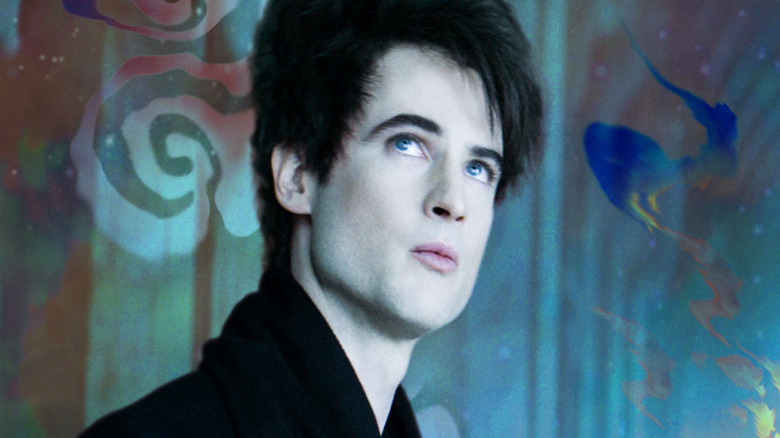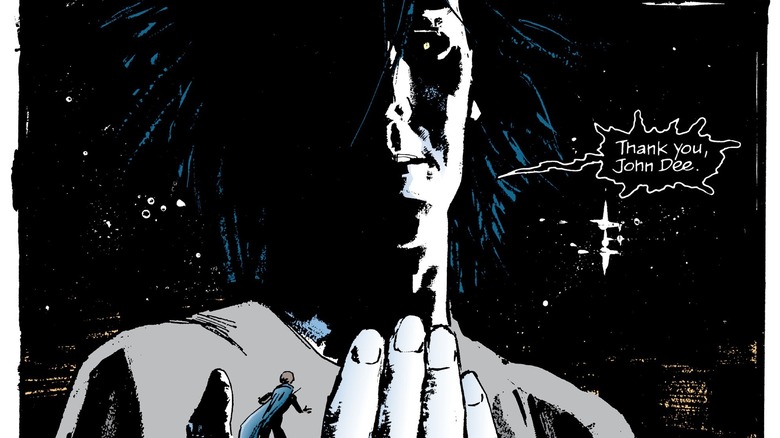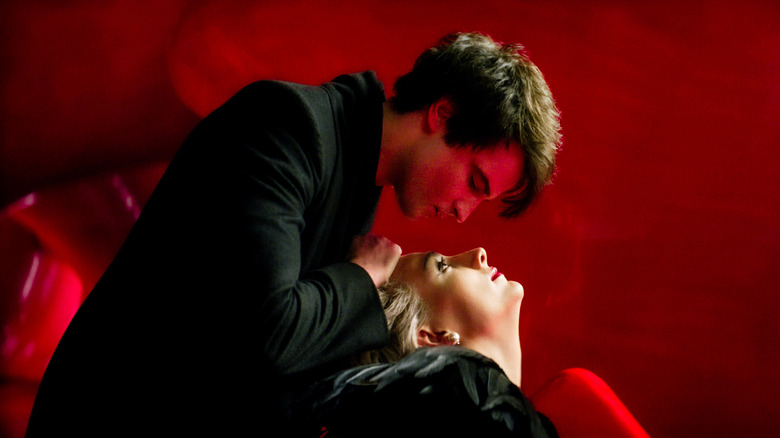The Big Difference Between Dream's Eyes In Netflix's Sandman And The Comics Explained
Warning: spoilers ahead for Netflix's "The Sandman."
Neil Gaiman's haunting comics series "The Sandman" has a troubled adaptation history, and has even been deemed "unfilmable." But after decades of false starts and development hell, Netflix has successfully adapted "The Sandman" into a TV series, with Gaiman, David S. Goyer, and Allan Heinberg at the helm. While the challenges of translating Gaiman's complex world to the small screen are multifold, the Netflix adaptation comes close to capturing the essence of the comics, despite its flaws.
"The Sandman" encapsulates various realms and characters but focuses primarily on Morpheus aka Dream (Tom Sturridge), one of the seven Endless, who is on a quest to reclaim his power. The Netflix series takes a slightly different route from Dream's look in the comics: Sturridge dresses like a goth teen and broods a lot, but can otherwise pass for human. This is markedly different from Dream's comics demeanor, wherein the Lord of Nightmare emits an otherworldly aura, has wild jet-black hair, and starry eyes that set him apart from humans in almost every scene.
Gaiman explained the decision to mostly do away with "the classic Dream eyes" for the show on Twitter, saying that the comics-accurate look "didn't really work" on screen:
You'll see the classic Dream eyes sometimes. (Look for them in episode 1 and Episode 2.) But yes, we tried the black contacts and the paper white skin and the big big hair and they didn't really work. When we got to the look we have now it felt right. https://t.co/NMdjB9yOhh
— Neil Gaiman (@neilhimself) August 4, 2022
Let's take a closer look into the differences between Dream's eyes in the comics and the Netflix series, along with what worked and what didn't.
Windows to the soul
Dream is a humanoid entity who roams Earth to carry out his function as the Lord of Dreams. In the comics, his eyes are a standout feature: they appear as two starry, void-like portals, hinting at his primordial nature and immense powers. While this would have been a fine addition to Sturridge's look in the adaptation, Gaiman explained on his official Tumblr that the look proved un-achievable due to practical reasons:
"Sometimes you need the eyes to convey information. We did a lot of make-up, contact lens, and CGI trials, tests, and experiments starting out, and reluctantly came to the conclusion that we didn't want to lose Tom's eyes, because when we did we diminished the magic of his performance."
Gaiman's explanation makes sense, as Sturridge emotes fairly well with his expressions alone and recreates Dream's perpetually-haunted look in the comics to good measure. Interestingly, episode 1 of the show, titled "Sleep of the Just," offers us a glimpse of Dream's comics eyes at key moments. When Dream is captured inside the glass structure, he looks right at the camera, with one of his eyes gleaming in an eerie way. The effect is brief and subtle, but works for the scene in question. Dream, an endlessly powerful being, is trapped against his will and is vulnerable, but the viewers are allowed a quick glimpse into what he is capable of. The Lord of Dreams and Nightmares can be cruel and ruthless when pushed to extremes, and the scene foreshadows this aspect of his character.
Creating an iteration that works
In an interview with Fandom, Sturridge also explained that the creators initially attempted to faithfully recreate Dream's wild, gaunt look, but it was tricky to incorporate into the storyline. Sturridge recalled that his face was painted "as white as an A4 piece of paper" and he even wore "black contacts with stars in them." This offbeat look, although comics-accurate, would prevent Dream from mingling with humans on the daily, as it would raise suspicion that an Endless walked the Earth. Sturridge elaborated:
"It [the initial look] really did look exactly like the Sandman we know, but what Neil said, which was so important, was that if Morpheus walks amongst the world, walks down the streets of New York, no one should bat an eyelid. He should have a presence, but no one should think that this endless being is amongst them ... And we slowly whittled it down to 'wait a second, Tom, you're sickly pale anyway, and your hair is always a mess, and when I look at your eyes I can see the cosmos.' So, we were fine."
Gaiman's insistence that Dream should be able to walk the streets without attracting too much attention is valid, as we see the character walking among humans for centuries in the series. In "The Sound of Her Wings," we see Dream granting immortality to Hob Gadling, whom he meets up with in a pub every 100 years. Dream's look changes as per the fashion of the times (the wigs are, erm, questionable), which means that the Dream Lord intends to appear as human as possible while doing his job. Starry eyes or not, Dream's powers are a force to reckon with, both in the comics and the Netflix adaptation.
"The Sandman" is currently streaming on Netflix.


